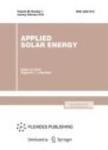版权所有:内蒙古大学图书馆 技术提供:维普资讯• 智图
内蒙古自治区呼和浩特市赛罕区大学西街235号 邮编: 010021

作者机构:Department of Electronics and Electrical Communications Faculty of Engineering Ain Shams University Cairo11517 Egypt Department of Engineering Physics Faculty of Engineering and Technology Future University Cairo Egypt Department of Computer Engineering Computer Science and Engineering College University of Ha’il Ha’il Saudi Arabia Department of Electrical Communication and Electronics Systems Engineering Faculty of Engineering Modern Science and Arts University Cairo Egypt Department of Engineering Physics and Mathematics Faculty of Engineering Ain Shams University Cairo11517 Egypt Department of Computer and Systems Engineering Faculty of Engineering Ain Shams University Cairo11517 Egypt
出 版 物:《Applied Solar Energy (English translation of Geliotekhnika)》 (Appl Sol Energy)
年 卷 期:2020年第56卷第5期
页 面:309-323页
核心收录:
学科分类:0808[工学-电气工程] 080802[工学-电力系统及其自动化] 080703[工学-动力机械及工程] 081203[工学-计算机应用技术] 08[工学] 0807[工学-动力工程及工程热物理] 0835[工学-软件工程] 0701[理学-数学] 0812[工学-计算机科学与技术(可授工学、理学学位)]
基 金:The authors thank Prof. Abdelhalim Zekry at Microelectronics Laboratory Faculty of Engineering Ain Shams University for his support
摘 要:Abstract: Due to the broad needs for energy as market demands, searching on how to improve the efficiency of the PV systems is an essential concern for researchers to worry about. So, it is crucial to force the PV system to work at its peak power point in order to get the maximum available power from the photovoltaic panel. This paper presents a comprehensive comparison between four Maximum Power Point Tracking (MPPT) Algorithms;Perturb and Observe (P&O), Incremental Conductance (INC), Modified Variable Step Size Perturb and Observe (M-VSS-P&O) and Modified Variable Step Size Incremental Conductance (M-VSS-INC) by using of the DC-DC boost converter for three different kinds of solar cells. These cells are polycrystalline KC200GT cell, monocrystalline shell SQ85 cell and thin film shell ST40 cell. Simulations have been performed using MATLAB-SIMULINK for the three types of solar cells to investigate their performance under both standard test conditions (STC) and slowly varying and sudden changes in solar irradiance. The study has considered the response time, output power efficiency and steady-state-oscillations. The simulation results of the modified algorithms show an improvement in the cell performance in steady state conditions, tracking time and boost converter efficiency as well as an enhancement in the dynamic response in tracking the maximum power point (MPP) in varying climatic conditions over conventional algorithms. © 2020, Allerton Press, Inc.